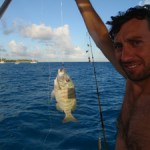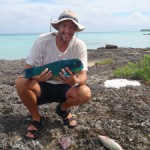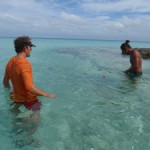Jul 14 2010
Life in 15 minute intervals
(concerning events: July 8th)
When on a passage, the people on board take turns being ‘on watch’. While on watch, that person is called the helmsman. They are in charge of sailing the boat, making sail changes if necessary, ensuring the proper course of the boat. The helmsman can ask other people for help in doing a task. Other people can take it upon themselves to tinker with sails, look at and adjust the course, etc. etc. if they are so inclined. The captain (Matt), if he feels like it since he’s the captain gets to do whatever he damn well pleases and tell the helmsman to piss off if wants. We, thankfully, have a benevolent captain (so far) who makes his requests much more politely. In the end, particularly through the night, it is the helmsman’s job to make sure the boat doesn’t hit anything.
My first overnight watch was not particularly exemplary. I was determined to improve upon this in my next one. Our passage from Apataki to Rangiroa would provide me with the first opportunity. I volunteered to take the midnight to 6 am shift .
Every 15 minutes the person on watch is supposed to at a minimum scan the horizon looking for anything we might run into. 15 minutes is the chosen interval aboard Syzygy as we believe it balances differing factors such as: how far you can see at night, how generally busy with other vessel traffic the area is, human comfort. We have a wristwatch aboard Syzygy that has an alarm set to ring every 15 minutes. I would wear it around the band of my headlamp so that it was always extremely close to my ear. Just in case I was sleeping or simply had my eyes deeply closed. I would even wear the watch during the day so that if I got busy doing something, when the alarm rang I would be reminded to, at a minimum, look around for other boats, land, check our course, etc.
Through the night, I noticed my life quickly become wholly defined by that alarm. I would wait for the alarm before I would do almost anything, so that I would be less likely to be in the middle of something when the alarm rang. I would plan to do different jobs by the alarm. “After two alarms I will _____________.”
Here is my night watch, my life, as defined by those 15 minute intervals.
11:45 pm – 1200 am
Look for coffee maker. Become frustrated at not being able to find it. Attempt to light stove for coffee. Continue frustrations at stove for not staying lit at a low flame, optimal for coffee making. Not processing what Matt is saying to me about his and Karen’s watch because I feel like a zombie and nauseous. I drink a large glass of juice because I know I need calories but can’t think of anything easy enough to make. Stomach feels queasy from the rocking motion of the boat as it pitches and rolls 10 degrees to each side.
12:00 am – 12:15 am
Coffee finishes boiling. up on deck listening to Matt. During the first part of my watch I need to take down the whisker pole, and bring in the fishing lines. At some point, we will need to heave to as we will have arrived at the entrance to the atoll but don’t want to go through the pass in the dark. Stomach feels queasy; I think the rolling of the boat has increased to 15 degrees to each side, though I’m probably imagining it. Eat granola bar for more calories and because a more full stomach usually helps me with seasickness. Alarm sounds.
12:15 am – 12: 30 am
Look around the horizon. Check course on computer. Pour coffee into cup. stomach feels awful, it’s not looking good. Boat is definitely, in my imagination, pitching 20 degrees to each side. Alarm sounds.
12:30 am – 12:45 am
Look around the horizon. Back down below to add milk and sugar to coffee. I imagine 30 degree rolling pitches to each side, a roller coaster fun house of nasea. Realize my stomach is done. Stomach is rising. Need to get outside immediately. Get halfway out the companionway, remember that I’m about to drape myself 1/2 off the boat and I’d better clip in. stomach in throat. Fumble with the tether trying to get clipped in. It takes ages. Stomach in mouth. Finally can step on deck knowing I’m tethered. Stomach in mouth, mouth forcibly closed to prevent a god awful mess in the cockpit. Fall into the jack lines, stomach exiting. Sit down on the boat, stick my head between the jack lines into a nice comfortable position and continue to throw up into a dark sea. I have to time my events with the rolling of the boat so as not to coat the sides of the hull. I’m not very good at this. Alarm sounds.
12:45 am
I give the alarm the bird, heave one more time and then drag myself up to look around. Nothing like taking a break from throwing up to look around for boat traffic. Fuck me. I then go back to the rail to hang out and watch water flow by the boat. It’s quite a sight. Mysteriously dark, the swell rising and falling. I listen to all the unique sounds that happen. Waves hitting up against the hull. The rush of water as we accelerate down the face of the wave. The ripples it makes as our boat cuts through at 6 knots. Light glistens off the surface particularly from the moon. Parts are eerily smooth, like an oil slick. Others are little whirlpools, particularly as it eddies off the back of our boat. Sea sickness seems to have gone away and I actually feel much better. Alarm sounds.
1:00 am
Look around. Get some water swish it around my mouth. Back to the rail to watch some more water. Able to sit up comfortably and look up at the stars. The stars are a treat. There are thousands, millions of them. On a cloudless, moonless night, the faintest stars are visible barely there to the straining eye. The brightest gleam dominantly. A milky way band stretches prominently across the sky. All new southern hemisphere stars to gaze at and wonder about. I know none of the constellations like I do in the Northern hemispere. A week later, safely at anchor and feeling much better, I’ll start making up names for constellations. A particular group of three forming a triangle gets called Allison. Tonight though, I just stare at them, looking at different ones as they glisten differently, sparkle with this color or that. A shooting star darts by, long enough so that I only see it in my peripheral vision, have time to move my head and eyes to focus on it and it is still goes for another second. Very cool. Alarm sounds.
1:15 am
Look around. Check course on computer. Get my coffee and bring it on deck. Take my first sip. It’s cold. Begin contemplating the tasks I have to do. Clean up the side of the boat, some off the lifelines and a little off the side deck. Alarm sounds.
1:30 am
Look around. Start bringing in the first fishing line. I am able to do this sitting down. This is good because I feel exhausted from my earlier bout of nasea. Realize that our tackle box is still quite a mess, despite some effort and time Matt put into organizing it. Once I finish pulling in the first line, I relax and wait. I don’t want to start on the second line and have to stop if the alarm goes off. I could look at the watch and see if I have enough time, but I prefer to just sit there and wait it out. One minute. Two, three, four, five. I probably could have pulled in the line by now. Alarm sounds.
1:45 am
Look around. Check course on computer. Bring in the second line. I endeavor to bring some semblance of order to tackle box while stowing the fishing lines. Alarm sounds.
2:00 am
Look around. Check course on computer. Make a plan for the next two alarm cycles. I plan to spend an extensive amount of time dealing with our course, checking our course on the computer, looking at how far we have to go, when we should heave-to, etc. Tasks such as these can take up nearly an entire cycle as the computer program we use, Mac-Enc is woefully slow. Embarrassingly slow for a program running on a Mac. After the time-consuming check, I’ll spend the remainder of that cycle and the next cycle resting. Then, I’ll begin taking down the whisker pole. Alarm sounds.
2:15 am
I look around for longer then necessary, using the binoculars to stare off at the lights from shore, eyeing each intensely to make sure it is not, in fact, a boat that might head for us. After doing the multiple tasks on a mind-numbingly slow Mac-Enc, I come back on deck and look around again. There is not much time left in this cycle, but I lie down and watch the stars. I close my eyes. Consider eating and become nauseous at the thought. I try to slow my breathing, trying to bring as much relaxation and rest as possible to a still awake but dehydrated and tired body. Alarm sounds.
2:30 am
Look around extremely quickly, as it was just three minutes or so that I last looked. Back to lying down. I close my eyes and let my thoughts drift. Idly thinking of people back home, what they might be doing, what changes are happening in their lives. Has Allison found a job yet? Has she gotten my letter? Is not communicating for three weeks hard? Did Dave’s school get approved? Has Maddi my niece gotten even more adorably cute? I try and drift as close to sleep as possible. Alarm sounds.
2:45 am
Still lying down in the cockpit with my eyes closed, giving myself 30 more seconds. As I’m opening up my eyes, I almost sense it before I even see it. A bright light, 20 degrees up the horizon and behind us, a boat would have to be close, TOO CLOSE for a light that bright. Close and large. “How could I have not seen a boat like that before!?!?” rushes through my head as I sit up with a quick start, brain fast into action as to what I’m going to have to do. I then heave a sigh and collapse back down onto the cushions in the cockpit, done staring at the moon for now. Thanks moon, thanks for that. Look around. I note an actual new light on the horizon. Could be more shore lights, but I’m inclined to think it’s a boat. Check course on computer. Back up on deck, I begin going through the steps to take down the whisker pole. On foredeck, unclip the pole. Slowly bring twenty foot pole to rest on deck. The boat has seen fit to make this task difficult by rolling 15 degrees to each side of vertical. Standing is generally out of the question, and so I lean/sit on the dinghy which is tied upside down on our foredeck. Pole down, a dozen more steps to go. Alarm sounds.
3:00 am
Of course the alarm sounds right now. I curse silently, then try and pin the pole down while I scan the horizon. The new light has definitely moved closer. Back to the whisker pole, I get the bridle off, loosen the topping lift so I can move the pole to it’s stowed position, Get the jib sheet off the pole, and begin moving the pole to the other side of the boat for stowage. Alarm sounds. Really? Already?
3:15 am
Look around. The light is now the shadow of a boat as it is slips by our port side. I finish stowing the pole. I then have to retrieve the whisker pole bridle and re-lead the jib sheet. Alarm sounds.
3:30 am
Look around. Check course on computer. I wake Matt up so we can heave to. He immediately notes the light, but I assure him it is moving away. We then heave-to, which simply means that we tack the boat without allowing the jib to move to the other side. This pins the jib sail up against the shrouds and stalls the boat. The jib tries to take the boat down-wind, while the main and the rudder act to counter by trying to drive the boat up into the wind. The idea is to completely stall. Alarm sounds.
3:45 am
Look around. A proper heave-to takes a bit of finesse. Our boat is also not particularly inclined to completely stop in it’s heave-to. We have slowed to a 1 knot however, from about 5 or 6. Matt and I look at the sail, banter about how to get us to completely stop. Matt starts to clean up lines and I say “Dude, go back to bed.” “Oh yea,” he replies, “See you at 6.” and disappears down the companionway. Alarm sounds.
4:00 am
Look around. Relax and aimlessly watch the stars and the water. Alarm sounds.
4:15 am
Look around. Check course on computer. Relax and aimlessly watch the stars and the water. Alarm sounds.
4:30 am
Look around. Relax and aimlessly watch the stars and the water. Alarm sounds.
4:45 am
Look around. Think that describing life in 15 minute segments might be an interesting blog post. Open up Matt’s computer to start writing. Alarm sounds.
5:00 am
Look around. Check course on computer. Continue writing. Then I think to myself, “Really?” and head back up on deck and calmly this time, tether in, sit down on the coamings of the cockpit, move my head between the life lines and throw-up. Alarm sounds.
5:15 am
Look around. Gurgle some water and feel exceedingly good except for my pride. What kind of a sailor am I that I can’t even look at a computer screen for a little while to type? So what the boat is rolling. How am I going to manage on a 5 day passage or 10? At least I’m not doubled over and incapacitated. Oddly, I’m actually in excellent spirits. I just would like to be able to do something on watch other than relax and aimlessly watch the stars and the water. Alarm sounds.
5:30 am
Look around. Relax and aimlessly watch the stars and the water. Alarm sounds.
5:45 am
Look around. Check course on computer. Relax and aimlessly watch the stars and the water. Alarm sounds.
6:00 am
Look around. Relax and aimlessly watch the stars and the water. Alarm sounds.
Matt gets up. While my watch is technically over, there is stuff to do like getting out of the heave-to and then motor sailing back to the pass which we have drifted to the west of and then a pass to enter. All things good for me to practice So I stay up and go through all of these. The pass into Rangiroa is exciting, with tall standing waves from a mix of currents and wind. The waves seem to tower over us as they roll in behind and then sweep under us. We get to anchorage, and Matt lets me suss out our options for anchoring and then pilot us into place. I’m not quite up to the task yet though, and so in the last bit Matt modestly gives out some directions on what to be doing. Once anchored, Matt go about the various little tasks that all have to been done after anchoring. We do these in silence. I am reminded of when after a long rock-climb, or a hike out from a canyon, when you have to do those last miserable details. We both know what needs to be done, and we go about it silently. After 45 minutes of slowly moving through these tasks, it is about 9 am. I crawl into bed and pass out.



